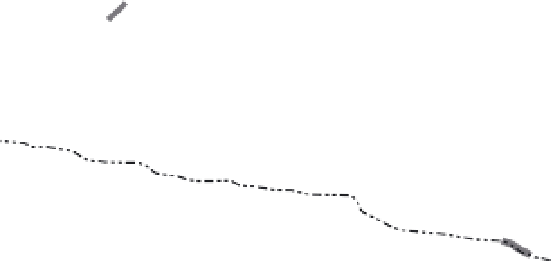Geology Reference
In-Depth Information
A
prograding
delta
landslide
dam
lake
beds
reworked
debris
active river
profile
bedrock river
profile
Landslide-Dominated River Profile
active
dam
B
Ge Sud Za He, Eastern Tibet
boulder
rapids
4
ponded
zone
landslide
scar
2
1
3
River Profile: Ge Sud Za He
C
1
bedrock erosion
2500
2
3
2300
2100
4
landslide
age: ~9 ka
1900
bedrock
1700
40
35
30
25
20
15
10
5
0
Distance from Junction (km)
Fig. 8.6
Impact of large landslides on river profiles.
A. Conceptual model for the geometry of deposition and the active river profile after a major landslide dam event.
Fluvial-lacustrine aggradation upstream of the dam occurs concurrently with downcutting through the crest of the
landslide. Bedrock is shielded from erosion both upstream and downstream from the slide. B. Geomorphic map of
four landslides, ponded zones, and boulder rapids along a river (Ge Sud Za He) in eastern Tibet. C. Long profile of
the Ge Sud Za He illustrating the lateral extent (>80%) of bedrock cover by landslide-related sediment. The largest
landslide (number 3) dates from ~9 ka, yet is still >150 m high. Modified after Ouimet
et al.
(2007).
steepness indices, abrupt changes in concavity,
and high calculated stream power can each be
related to landsliding, rather than to incision
along a predominantly bedrock profile.
upstream. Such migration is a key process in tec-
tonic geomorphology because it serves to commu-
nicate changes from downstream to the upstream
parts of the network. A steepened reach could
develop in the absence of tectonism (or eus-
tatic change) simply due to a difference in the
erodibility of the bedrock: more resistant rocks
will tend to underlie steeper reaches of a stream
(Fig. 8.9B). We are more interested in tectonically
generated knickpoints that form through differ-
ential folding or faulting of a reach of a river.
Normal faulting in which the downthrown (hang-
ing-wall) block is in the downstream direction
causes a step (knickpoint) to develop in the lon-
gitudinal profile of the river. Similarly, thrust
faulting that differentially uplifts an upstream
reach with respect to a downstream reach will
create a knickpoint. In either case, the base level
Knickpoints
When a reach of a stream is steepened with
respect to the adjoining reaches, it defines a
topographic
knickpoint
(Fig. 8.7). Because the
river typically is no longer in equilibrium, the
channel will begin to adjust its longitudinal
profile. Across the steepened knickpoint, stream
power will typically increase due to the increased
slope, and erosion of the stream bed will be
enhanced. The common effect of this erosion is
to cause the knickpoint to migrate or propagate



























































































































